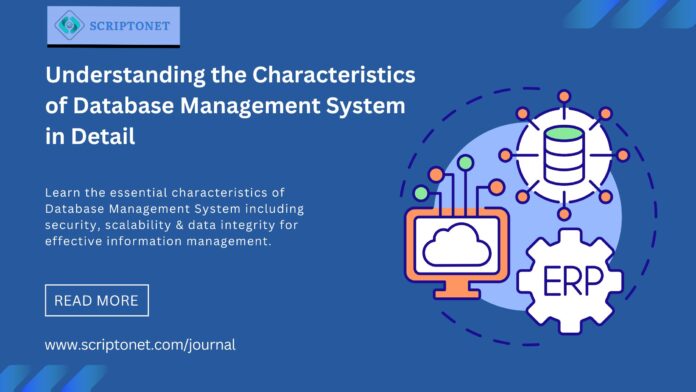Introduction
Database Management Systems (DBMS) serve as the backbone of modern information storage & retrieval. These sophisticated software applications handle vast amounts of data while ensuring reliability, security & efficiency. Understanding the characteristics of Database Management System becomes essential for anyone working with data-driven applications or organizations.
The characteristics of Database Management System define how these systems organize, store & manage information. From small business applications to enterprise-level solutions, DBMS platforms share common traits that make them indispensable in today’s digital landscape.
This comprehensive guide explores the fundamental characteristics of Database Management Systems, examining their historical development, practical applications & diverse perspectives. We’ll analyze how these characteristics work together to create robust data management solutions.
Data Independence & Abstraction
This feature separates the physical storage of data from how applications access it. Users & applications interact with data through logical views without worrying about storage mechanisms.
Data abstraction works on multiple levels. The physical level deals with how data gets stored on hardware. The logical level defines the structure & relationships between data elements. The view level presents customized data presentations to different users.
This separation brings tremendous benefits. Developers can modify storage methods without changing application code. Database administrators can optimize performance without affecting user experiences. Changing storage strategies or upgrading hardware gives organizations more leeway.
Consider how online banking systems work. Customers see account balances & transaction histories through clean interfaces. Behind the scenes, complex storage systems manage millions of records across multiple servers. Users never need to understand these technical details.
Data Integrity & Consistency
Various integrity mechanisms help maintain data accuracy in database systems .These characteristics of Database Management Systems ensures information reliability.
Integrity of entities makes certain that each record has a unique identifier. Data values are limited to formats or ranges that are acceptable by domain integrity.
Transaction management helps in maintaining consistency. When multiple operations must complete together, DBMS platforms use Atomicity, Consistency, Isolation, Durability (ACID) properties to guarantee reliable outcomes.
Banking transactions illustrate this perfectly. The entire transaction is rolled back to prevent data corruption if any step fails.
Validation rules provide another layer of protection. These rules check data quality before accepting new information. For example, email fields must contain valid email formats & age fields cannot accept negative numbers.
Concurrent Access & Multi-User Support
Modern databases must handle multiple users simultaneously. This characteristic of Database Management System enables organizations to share information efficiently while maintaining data integrity.
When multiple users modify the same data, concurrency control prevents conflicts. Lock mechanisms temporarily restrict access to prevent simultaneous changes. Timestamp ordering ensures operations complete in logical sequences.
Different isolation levels balance performance with consistency requirements. Read uncommitted allows maximum concurrency but risks viewing incomplete changes. Serializable provides complete isolation but may reduce performance.
Multi-version concurrency control offers an elegant solution. Since this method keeps multiple versions of the data, readers can access the same snapshots while authors make changes without blocking others.
Real-world applications demonstrate these benefits. E-commerce websites handle thousands of simultaneous customers browsing products, adding items to carts & completing purchases. Without proper concurrency control, inventory counts could become inaccurate or orders might get lost.
Data Security & Access Control
Security is one of the most critical characteristics of a Database Management System. These platforms protect sensitive information through multiple layers of defense mechanisms.
Authentication verifies user identities before granting system access. What authorized users are able to perform with particular data items depends on authorization. Encryption protects data both in storage & during transmission.
Role-Based Access Control (RBAC) simplifies security management. Administrators create roles with specific permissions, then assign users to appropriate roles. This approach reduces complexity while maintaining granular control over data access.
Audit trails track user activities within database systems. These logs help organizations monitor access patterns, detect suspicious behavior & meet compliance requirements.
Healthcare systems exemplify robust security implementations. Patient records require strict access controls to comply with privacy regulations. Medical staff can only access information relevant to their responsibilities & all access gets logged for regulatory compliance.
Backup & Recovery Capabilities
Data protection through backup & recovery mechanisms represents another essential characteristic of Database Management System. These features protect against hardware failures, software errors & human mistakes.
Incremental backups save only changes since the last backup, reducing storage requirements & backup windows.
Transaction log backups provide point-in-time recovery capabilities. These logs record all database changes, enabling restoration to any moment between backups.
Hot backups allow data protection without stopping database operations. This capability ensures business continuity for systems that cannot tolerate downtime.
Recovery procedures vary based on failure types. Simple hardware failures might require restoring from recent backups. Corruption issues could need point-in-time recovery to moments before problems occurred.
Financial institutions demonstrate sophisticated backup strategies. These organizations maintain multiple backup copies across different geographic locations, ensuring data availability even during major disasters.
Query Processing & Optimization
Efficient data retrieval represents a fundamental characteristic of Database Management System. Query processors translate user requests into optimized execution plans that minimize resource consumption.
Data manipulation techniques are provided by Structured Query Language (SQL). Users write declarative statements describing desired results rather than specifying exact procedures.
Multiple execution strategies are analyzed & the most efficient approach is selected by Query optimizers. These systems consider factors like data distribution, available indices, etc.
Indexing structures accelerate data retrieval by creating shortcuts to specific information.Hashing indexes are for exact matches, and B-tree indexes are for range searches.
Caching techniques help speed up retrieval by storing frequently used material in memory. Buffer pools manage memory allocation between different data pages & query results.
Search engines demonstrate advanced query optimization. These systems process millions of queries daily, using sophisticated algorithms to deliver relevant results within milliseconds.
Scalability & Performance Management
Growth accommodation represents another vital characteristic of a Database Management System. These platforms should handle increasing data volumes, user counts & transaction rates without any significant performance degradation.
- More powerful hardware is added to existing servers by vertical scaling. This approach works well for moderate growth but eventually hits physical limitations.
- Horizontal scaling distributes workloads across multiple servers. Sharding splits data based on specific criteria, while replication creates copies for improved availability & performance.
- Load balancing distributes incoming requests across available resources. This method keeps individual servers from experiencing overload.
- Performance monitoring tools help administrators identify optimization opportunities. These systems track metrics like response times, resource utilization, etc.
Social media platforms showcase massive scalability requirements. These applications store billions of posts, photos & user interactions while maintaining responsive performance for global audiences.
Data Modeling & Schema Management
Database Management Systems excel at structuring & organizing information through systematic approaches to data architecture. These comprehensive platforms offer sophisticated mechanisms for establishing data frameworks, defining interconnections & implementing business rules.
The tabular approach of relational databases arranges information into structured grids where each row represents a distinct record & columns define specific attributes. This methodology proves particularly effective when handling well-defined datasets where connections between different data elements follow predictable patterns.
Visual modelling through entity-relationship frameworks enables designers to map out complex data architectures before implementation. These graphical representations serve as foundational blueprints that guide the construction & deployment of database solutions.
Data normalization processes systematically reduce information duplication while enhancing overall data integrity. Through methodical decomposition, complex data arrangements transform into streamlined, maintainable structures that eliminate inconsistencies.
Modern database platforms support dynamic structural modifications through schema management capabilities, allowing organizations to adapt their data architecture without compromising existing information assets. Comprehensive change tracking & restoration features provide safety nets for database evolution initiatives.
Enterprise customer management platforms exemplify sophisticated data modelling in practice. These integrated systems weave together customer profiles, transaction histories, service interactions & promotional activities into cohesive information networks that support comprehensive business intelligence & operational efficiency.
Conclusion
Strong data management platforms are produced by combining the features of database management systems. These features enable organizations to store, retrieve & manipulate information efficiently while maintaining security, integrity & performance.
Understanding these characteristics helps decision-makers select appropriate database solutions for their specific needs. Different applications require different emphasis on various DBMS features.
Modern businesses depend on reliable data management systems. The characteristics of Database Management System continue evolving to meet growing demands for speed, scale & functionality.
Takeaways
- Database Management Systems provide essential characteristics that make modern data management possible.
- Data independence allows flexibility in storing & accessing methods. Integrity mechanisms ensure information accuracy & consistency.
- Concurrent access enables multiple users to work simultaneously without conflicts. Security features protect sensitive information through encryption methods.
- Backup & recovery capabilities safeguard against data loss from various failure scenarios.
- Scalability features accommodate the increase in user demands. Data modelling tools help organize information structures logically & efficiently.
- The characteristics of Database Management Systems discussed above work together to create robust platforms that support modern digital operations across diverse industries & applications.
Frequently Asked Quesions (FAQ)
What are the primary characteristics of DBMS ?
The primary characteristics of Database Management System include data independence, integrity maintenance, concurrent access support, security controls, backup & recovery capabilities, query optimization, scalability features & data modelling tools. These characteristics work together to provide reliable, efficient & secure data management platforms.
How characteristics of DBMS ensure data security?
Database Management Systems ensure data security through multiple mechanisms, including user authentication, Role-Based Access Control (RBAC), data encryption, audit trails & backup procedures. These security characteristics protect sensitive information from unauthorized access, modification or loss while maintaining system performance & usability.
Why are backup & recovery important characteristics of Database Management System?
Backup & recovery represent critical characteristics of Database Management System because they protect against data loss from hardware failures, software errors, human mistakes or disasters. These capabilities ensure business continuity by providing methods to restore information to previous states when problems occur.
How do characteristics of Database Management System support multiple users?
Multi-user database environments rely on sophisticated coordination techniques to manage simultaneous access patterns, including transactional oversight, data isolation protocols & resource reservation methods. These fundamental capabilities ensure conflict-free operations when numerous users interact with identical datasets concurrently, while preserving both operational efficiency & information accuracy.
Database platforms implement advanced synchronization frameworks that orchestrate parallel user activities through careful resource allocation & access sequencing. By establishing protective barriers around critical data operations & managing the timing of user interactions, these systems maintain consistent information states across all concurrent sessions.


